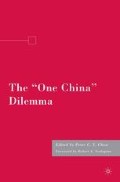Abstract
Aconsiderable amount of scholarly effort has been dedicated to understanding the character and evolution of national identity on the Republic of China (ROC) or Taiwan. Most research has treated national identity as the dependent variable explained by Taiwan’s separation from the mainland, 1949 arrival of the ROC capital, economic development, and democratization process. The key exception is studies that examine the linkage between elite manipulation of national identity and Taipei’s cross-Strait policy. Less research has been devoted to developing a broader theoretical understanding of the effect of the identity debate on Taiwan’s international image and subsequent relationships.
Access this chapter
Tax calculation will be finalised at checkout
Purchases are for personal use only
Preview
Unable to display preview. Download preview PDF.
Notes
Ronald Jepperson, Alexander Wendt, and Peter J. Katzenstein, “Norms, Identity, and Culture in National Security,” in The Culture of National Security: Norms and Identity in World Politics, ed. Peter Katzenstein (New York: Colombia University Press, 1996), pp. 33–75.
Frederick Hertz, Nationality in History and Politics (London: Routledge and Kegan Paul, 1957), p. 3.
Benedict R. Anderson, Imagined Communities: Reflections on the Origin and Spread of Nationalism (New York: Verso, 1991).
Lynn White and Li Cheng, “China Coast Identities: Regional, National, and Global,” in China’s Quest for National Identity, ed. Lowell Dittmer and Samuel S. Kim (Ithaca NY: Cornell University Press, 1993), pp. 154–193.
Consuelo Cruz, “Identity and Persuasion: How Nations Remember Their Pasts and Make their Futures,” World Politics, vol. 52 (2000), pp. 277, 275–312.
Ernst Haas, Nationalism, Liberalism, and Progress (Ithaca: Cornell University Press, 1997), p. 23.
See, for example, Haas, Nationalism, Liberalism, and Progress; F. H. Hinsley, Nationalism and the International System (New York: Oceana Publications, 1973)
John Hutchinson, Modern Nationalism (London: Fontana Press, 1994)
James Mayall, Nationalism and International Society (Cambridge: Cambridge University Press, 1990).
See, for example, Wolfgang Schuluchter, The Rise of Western Rationalism: Max Weber’s Developmental History (Berkeley: University of California Press, 1981).
K. E. Boulding, “National Images and International Systems,” Journal of Conflict Resolution, vol. 2 (1959), pp. 120–121.
Philip Johnson-Laird, Mental Models (Cambridge, MA: Harvard University Press, 1983).
Richard Herrmann et al., “Images in International Relations: An Experimental Test of Cognitive Schemata,” International Studies Quarterly, vol. 41 (1997), pp. 403–433.
Lucian Pye and Sidney Verba, Political Culture and Political Development (Princeton: Princeton University Press, 1965), p. 111.
Allen Chun, “From Nationalism to Nationalizing: Cultural Imagination and State Formation in Postwar Taiwan,” The Australian Journal of Chinese Affairs, vol. 31 (1994), p. 51.
Shelley Rigger, “Competing Conceptions of Taiwan Identity: The Irresolvable Conflict in Cross-Strait Relations,” Journal of Contemporary China, vol. 6 (Summer 1997), pp. 307–318.
For a detailed review of Washington, DC —Taipei relations, please see Kerry B. Dumbaugh, “Taiwan: Recent Developments and US Policy Choices” (Washington, DC: Congressional Research Service, 2006).
See, for example, Yun-han Chu, “Taiwan’s National Identity Politics and the Prospect for Cross-Strait Relations,” Asian Survey, vol. 44 (2004), pp. 484–512
Thomas Gold. “The Status Quo Is Not Static: Mainland-Taiwan Relations,” Asian Survey, vol. 27 (1987), pp. 3, 300–315
Shelley Rigger, “Social Science and National Identity: A Critique,” Pacific Affairs, vol. 72 (1999–2000), pp. 537–552.
Two recent exceptions to this are — Melissa J. Brown, Is Taiwan Chinese? The Impact of Culture, Power, and Migration on Changing Identities (Berkeley: University of California Press, 2004)
Leo T. S. Ching. Becoming “Japanese”: Colonial Taiwan and the Politics of Identity Formation (Berkeley: University of California Press, 2001).
Joseph Bosco, “The Emergence of a Popular Culture,” in The Other Taiwan: 1945 to the Present, ed. Murray Rubenstein (New York: M. E. Sharpe, 1994), pp. 392–403
Yun-han Chu and Jih-wen Lin, “Political Development in 20th Century Taiwan: State-Building, Regime Transformation, and the Construction of National Identity,” The China Quarterly, vol. 165 (March 2001)
Keith Maguire, The Rise of Modern Taiwan (Aldershot, UK: Ashgate, 1998)
Hans Stockton “Partisanship, Ethnic Identification, and Citizen Attitudes toward Regime and Government on Taiwan,” Journal of Contemporary China, vol. 15 (2006), pp. 705–721.
See, for example, Yun-han Chu, “Taiwan’s Year of Stress,” Journal of Democracy, vol. 16 (2006), pp. 43–57
Cheng-yi Lin and Wen-cheng Lin, “Democracy, Divided National Identity, and Taiwan’s National Security,” Taiwan Journal of Democracy, vol. 1 (2006), pp. 69–88.
Chien-pin Lin, “Taiwan’s Participation in Inter-Governmental Organizations: An Overview of Its Initiatives,” Asian Survey, vol. 46 (2006), pp. 597–614.
Editor information
Copyright information
© 2008 Peter C. Y. Chow
About this chapter
Cite this chapter
Stockton, H. (2008). National Identity, International Image, and a Security Dilemma: The Case of Taiwan. In: Chow, P.C.Y. (eds) The “One China” Dilemma. Palgrave Macmillan, New York. https://doi.org/10.1057/9780230611931_6
Download citation
DOI: https://doi.org/10.1057/9780230611931_6
Publisher Name: Palgrave Macmillan, New York
Print ISBN: 978-1-349-53950-5
Online ISBN: 978-0-230-61193-1
eBook Packages: Palgrave Economics & Finance CollectionEconomics and Finance (R0)

